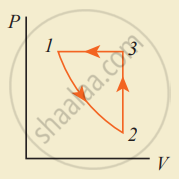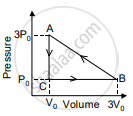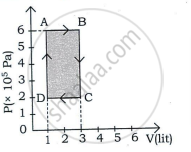Advertisements
Advertisements
प्रश्न
Consider the following cyclic process consist of isotherm, isochoric and isobar which is given in the figure.

Draw the same cyclic process qualitatively in the V-T diagram where T is taken along the x-direction and V is taken along the y-direction. Analyze the nature of heat exchange in each process.
उत्तर
Process 1 to 2: increase in volume. So heat must be added.
Process 2 to 3: Volume remains constant. Increase in temperature. The given heat is used to increase the internal energy.
Process 3 to 1: Pressure remains constant. Volume and Temperature are reduced. Heat flows out of the system. It is an isobaric compression where the work is done on the system.

Explanation: In the graph, during the process (1 to 2), the gas undergoes isothermal expansion. It receives a certain amount of heat from its surroundings. It uses this heat in doing the work. Hence internal energy of the gas remains unchanged.
During the process represented by (2 to 3), the gas is heated at a constant volume. Since no work is done and volume does not change, the process is an isochoric process.
Since heat is transferred to the gas from the surroundings, the internal energy of the gas is increased. During the process represented by (3 to 1), the gas is compressed isobarically. Work is done on the gas. Since temperature drops internal energy is reached. Hence the gas gives up heat to the surroundings.
APPEARS IN
संबंधित प्रश्न
Draw a p-V diagram of the reversible process.
Give an expression for work done in an isothermal process.
Draw the PV diagram for the adiabatic process.
Draw the PV diagram for the isobaric process.
Explain in detail an adiabatic process.
Explain in detail the isochoric process.
An ideal gas is taken in a cyclic process as shown in the figure. Calculate
- work done by the gas
- work done on the gas
- Net work done in the process

A monoatomic gas of pressure p having volume V expands isothermally to a volume 2V and then adiabatically to a volume 16V. The final pressure of the gas is ____________.
`("ratio of specific heats" = 5/3)`
In the figure shown here, the work done in the process ACBA is ______.

An ideal gas is taken through a cyclic process ABCDA as shown in figure. The net work done by the gas during the cycle is ______.

